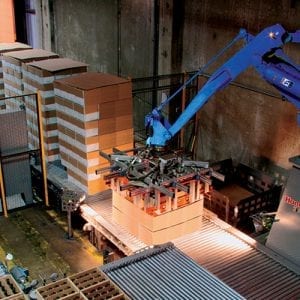
View original at www.therobotreport.com
By Matt Wicks, Chief Robotics Solution Architect Automated palletizing solutions, whether conventional or robotic, can offer significant productivity and efficiency improvements to your operation while taking up minimal floor space. Of the two, robotic palletizing systems have become increasingly popular in recent years, both for their flexibility and easy adaptability to changing needs and products. This article is designed to help you decide if robotic palletizing systems are right for you. Even if you have low-volume production lines, robotic palletizing could increase the throughput of your upstream operations and ease labor challenges. You can also learn more about the full range of solutions offered by Honeywell Intelligrated in our Palletizers and Depalletizers brochure . Advantages of robotic palletizing over conventional systems Many variables need to be considered when determining whether your operation is better served by robotic or conventional palletizing. Robots may seem high-tech, but they ultimately need to be practical. While every site has its own unique needs, robotic palletizing tends to outperform conventional solutions in applications like these: Low-speed, simple case palletizing — The limited hardware requirements of these applications make them ideal for robotic palletizing. As long as processes permit manual intervention (for example, to replace pallets or remove full loads), all you may need to account for are infeed conveyor, robot and safety standards. Low-speed, multi-line case palletizing — A palletizing robot can simplify multi-line palletizing by eliminating the need for complex upstream accumulation conveyor systems. Graphics-driven software also makes it easier for end users to change how pallets are built in response to new SKUs or other inventory changes. Bag palletizing — Clamshell tooling allows a jointed-arm robot to handle bags without disturbing their contents, producing straight and square loads. The robot can also palletize bags above 20 cycles per minute — and doesn’t […]



Leave a Reply
You must be logged in to post a comment.